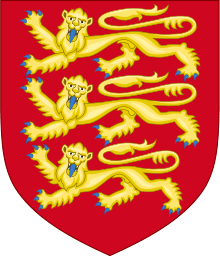Richard, 1st Earl of Cornwall
| Richard | |
|---|---|
 Seal of Richard, Earl of Cornwall, recto. On his shield he displays the Royal arms of England | |
| King of the Romans | |
| Reign | 13 January 1257 – 2 April 1272 |
| Coronation | 27 May 1257 |
| Predecessor | William II of Holland |
| Successor | Rudolph I of Germany |
| Earl of Cornwall | |
| Predecessor | Henry FitzCount |
| Successor | Edmund, 2nd Earl |
| Born |
5 January 1209 Winchester Castle, Hampshire, England |
| Died |
2 April 1272 (aged 63) Berkhamsted Castle, Hertfordshire, England |
| Burial | Hailes Abbey, Gloucestershire |
| Spouse |
Isabel Marshal Sanchia of Provence Beatrice of Falkenburg |
| Issue See details |
Henry of Almain Edmund, 2nd Earl of Cornwall Sir Richard of Cornwall |
| House | Plantagenet |
| Father | John, King of England |
| Mother | Isabella of Angoulême |
Richard (5 January 1209[1] – 2 April 1272), second son of John, King of England, was the nominal Count of Poitou (1225–43),[2] Earl of Cornwall (from 1225) and King of Germany (from 1257). He was one of the wealthiest men in Europe and joined the Barons' Crusade, where he achieved success as a negotiator for the release of prisoners and assisted with the building of the citadel in Ascalon.
Biography
Early life
He was born 5 January 1209 at Winchester Castle, the second son of John, King of England and Isabella of Angoulême. He was made High Sheriff of Berkshire at the age of only eight, was styled Count of Poitou from 1225 and in the same year, at the age of sixteen, his brother King Henry III gave him Cornwall as a birthday present, making him High Sheriff of Cornwall. Richard's revenues from Cornwall helped make him one of the wealthiest men in Europe. Though he campaigned on King Henry's behalf in Poitou and Brittany, and served as regent three times, relations were often strained between the brothers in the early years of Henry's reign. Richard rebelled against him three times, and had to be bought off with lavish gifts.
In 1225 Richard traded with Gervase de Tintagel, swapping the land of Merthen (originally part of the manor of Winnianton) for Tintagel Castle.[3] It has been suggested that a castle was built on the site by Richard in 1233 to establish a connection with the Arthurian legends that were associated by Geoffrey of Monmouth with the area. The castle was built in a more old-fashioned style for the time to make it appear more ancient. Richard hoped that, in this way, he could gain the Cornish people's trust, since they were suspicious of outsiders. The castle itself held no real strategic value.
The dating to the period of Richard has superseded Ralegh Radford's interpretation which attributed the earliest elements of the castle to Earl Reginald de Dunstanville and later elements to Earl Richard.[4] Sidney Toy, however, has suggested an earlier period of construction for the castle.[5]
Marriage to Isabel, 1231–40
In March 1231 he married Isabel Marshal, the wealthy widow of the Earl of Gloucester, much to the displeasure of his brother King Henry, who feared the Marshal family because they were rich, influential, and often opposed to him. Richard became stepfather to Isabel's six children from her first husband. In that same year he acquired his main residence, Wallingford Castle in Berkshire (now Oxfordshire), and spent much money on developing it. He had other favoured properties at Marlow and Cippenham in Buckinghamshire. Isabel and Richard had four children, of whom only their son, Henry of Almain, survived to adulthood. Richard opposed Simon de Montfort, and rose in rebellion in 1238 to protest against the marriage of his sister, Eleanor, to Simon. Once again he was placated with rich gifts. When Isabel was on her deathbed in 1240, she asked to be buried next to her first husband at Tewkesbury, but Richard had her interred at Beaulieu Abbey instead. As a pious gesture, however, he sent her heart to Tewkesbury.
On Crusade and marriage to Sanchia, 1240–43
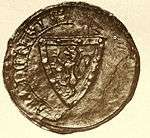
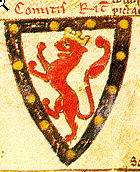
Later that year Richard departed for the Holy Land, leading the second host of crusaders to arrive during the Barons' Crusade. He fought no battles but managed to negotiate for the release of prisoners (most notably Amaury VI of Montfort) and the burials of crusaders killed at a battle in Gaza in November 1239. He also refortified Ascalon, which had been demolished by Saladin. On his return from the Holy Land, Richard visited his sister Isabella, the empress of Frederick II.
After the birth of Prince Edward in 1239, provisions were made in case of the king's death, which favoured the Queen and her Savoyard relatives and excluded Richard. To keep him from becoming discontented King Henry and Queen Eleanor brought up the idea of a marriage with Eleanor's sister Sanchia shortly after his return on 28 January 1242. On his journey to the Holy Land, Richard had met her in Provence, where he was warmly welcomed by her father Raymond Berenger IV and had fallen in love with this beautiful girl.[7] Richard and Sanchia (whom the English called Cynthia) married at Westminster in November 1243.
This marriage tied him closely to the royal party. Eleanor and Sanchia's youngest sister Beatrice would marry Charles I of Naples, while their oldest sister Margaret had married Louis IX of France. The marriages of the kings of France and England, and their two brothers to the four sisters from Provence improved the relationship between the two countries, which led up to the Treaty of Paris.[8]
Poitou and Sicily
Richard was appointed count of Poitou some time before August 1225.[9] However, Richard's claims to Gascony and Poitou were never more than nominal, and in 1241 King Louis IX of France invested his own brother Alphonse with Poitou. Moreover, Richard and Henry's mother, Isabella of Angoulême, claimed to have been insulted by the French queen. They were encouraged to recover Poitou by their stepfather, Hugh X of Lusignan, but the expedition turned into a military fiasco after Lusignan betrayed them.[10] Richard conceded Poitou around December 1243.[9]
The pope offered Richard the crown of Sicily, but according to Matthew Paris he responded to the extortionate price by saying, "You might as well say, 'I make you a present of the moon – step up to the sky and take it down.'"[11] Instead, his brother King Henry purchased the kingdom for his own son Edmund.
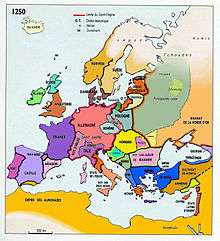
Elected King of Germany, 1256
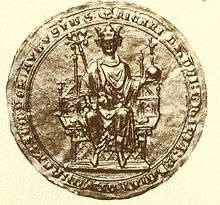
Although Richard was elected in 1256 as King of Germany by four of the seven German Electoral Princes (Cologne, Mainz, the Palatinate and Bohemia), his candidacy was opposed by Alfonso X of Castile who was elected by Saxony, Brandenburg and Trier. The pope and King Louis IX of France favoured Alfonso, but both were ultimately convinced by the powerful relatives of Richard's sister-in-law, Eleanor of Provence, to support Richard. Ottokar II of Bohemia, who at first voted for Richard but later elected Alfonso, eventually agreed to support the earl of Cornwall, thus establishing the required simple majority. So Richard had to bribe only four of them, but this came at a huge cost of 28,000 marks. On 27 May 1257 the archbishop of Cologne himself crowned Richard "King of the Romans" in Aachen;[12] however, like his lordships in Gascony and Poitou, his title never held much significance, and he made only four brief visits to Germany between 1257 and 1269.
Later life, death and successors

He founded Burnham Abbey in Buckinghamshire in 1263, and the Grashaus, Aachen in 1266.
He joined King Henry in fighting against Simon de Montfort's rebels in the Second Barons' War (1264–67). After the shattering royalist defeat at the Battle of Lewes, Richard took refuge in a windmill, was discovered, and was imprisoned until September 1265.
In December 1271, he had a stroke. His right side was paralysed and he lost the ability to speak. On 2 April 1272, Richard died at Berkhamsted Castle in Hertfordshire. He was buried next to his second wife Sanchia of Provence and Henry of Almain, his son by his first wife, at Hailes Abbey, which he had founded.
After his death, a power struggle ensued in Germany, which only ended in 1273 with the emergence of a new Roman King, Rudolph I of Habsburg, the first scion of a long-lasting noble family to rule the empire. In Cornwall, Richard was succeeded by Edmund, son of his second wife Sanchia.
Marriages and legitimate progeny
Richard of Cornwall married three times and had six legitimate children, but not a single grandchild. His first wife, Isabel Marshal, was the daughter of William Marshal, 1st Earl of Pembroke by his wife Isabel de Clare, daughter of Sir Richard "Strongbow" de Clare and Aoife MacMurrough. The wedding was held on 30 March 1231 at Fawley, Buckinghamshire. Richard and Isabel became the parents of four children, of whom only one reached adulthood. They were:[13]
- John of Cornwall (31 January 1232 – 22 September 1232), born and died at Marlow, Buckinghamshire, buried at Reading Abbey.
- Isabel of Cornwall (c. 9 September 1233 – 6 October 1234), born and died at Marlow, Buckinghamshire, buried at Reading Abbey.
- Henry of Cornwall (2 November 1235 – 13 March 1271). Known as "Henry of Almain" (Germany), he was murdered by his cousins, the Montfort brothers Guy and Simon. He was buried at Hailes Abbey in Gloucestershire. He had no children.
- Nicholas of Cornwall (b. & d. 17 January 1240 at Berkhamsted Castle), died shortly after birth, buried at Beaulieu Abbey with his mother.
Isabel died on 17 January 1240 while giving birth at Berkhamsted Castle. She was buried at Beaulieu Abbey. Nearly four years passed before Richard married again. His second wife, Sanchia of Provence (c.1225 – 9 Nov 1261) was the daughter of Raymond, Count of Provence by his wife Beatrice of Savoy. Sanchia was the third of four sisters; her elder sisters were the Queens of France and England, and her younger sister would later become Queen of Sicily. The match was arranged by Sanchia's elder sister Queen Eleanor, wife of Richard's older brother Henry III. Their wedding took place at Westminster Abbey on 23 November 1243. Richard and Sancha became the parents of two sons:[14]
- unnamed son (Jul 1246 - 15 Aug 1246).
- Edmund, 2nd Earl of Cornwall (c. 01 Jan 1250 – c. 25 Sep 1300), usually styled Edmund of Almain. Edmund married Margaret de Clare (1250 - shortly before Nov 1312), daughter of Richard de Clare, Earl of Gloucester by his second wife, Maud de Lacy, daughter of John de Lacy, 2nd Earl of Lincoln. Edmund and Margaret had no children. Their marriage was annulled in February 1294.
Sanchia died 9 November 1261 at Berkhamsted Castle and was buried 15 November in Hailes Abbey in Gloucestershire.[15] Richard's third wife, Beatrice of Falkenburg was the daughter of Dietrich I, Count of Falkenburg, and was said to be one of the most beautiful women of her time. Her father was a supporter of Richard's claim to the imperial throne. The two men fought in a battle together, at which time Richard met Beatrice and grew besotted by her. There was a colossal difference in age between them: at the time of their wedding in 1269, she was about fifteen years old whereas he was in his sixty-first year. Indeed, the youngest of Richard's children was four years older than Beatrice. Nevertheless, the two were married on 16 June 1269 at Kaiserslautern. Richard doted on his little wife, and she had a high regard for him, but they had no children together.[16] Beatrice survived Richard and died five years after him, having never married again. She died on 17 October 1277 and was buried before the high altar at the Church of the Grey Friars in Oxford.[16]
Mistress and illegitimate progeny
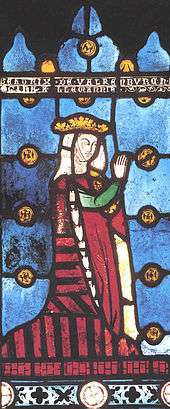
Richard formed a liaison with Joan de Valletort widow of Ralph de Valletort.[17] Joan later married Alexander Okeston and they were the parents of Sir James Okeston,[18] feudal baron of Harberton, Devon[19] and feudal baron of Trematon, Cornwall. Alexander was granted Modbury, Devon, part of the Valletorts' feudal barony of Harberton, following his marriage to the Earl of Cornwall's mistress, Joan, widow of Ralph de Valletort, by Roger de Valletort, Ralph's brother.[17] With the Earl of Cornwall, Joan de Valletort had three sons and two daughters:[20]
- Philip of Cornwall, a priest.
- Sir Richard of Cornwall, who received a grant from his half-brother Edmund, 2nd Earl of Cornwall, (d. 1300) in which he was called "brother". He married Joan FitzAlan, daughter of John FitzAlan, 6th Earl of Arundel, and by her had three sons and a daughter. He was slain by an arrow at the Siege of Berwick in 1296. His daughter, Joan of Cornwall, married Sir John Howard, from whom the Howard family, Dukes of Norfolk, are descended.[21]
- Sir Walter of Cornwall, who received a grant of the royal manor of Brannel,[22] Cornwall, from his half-brother Edmund, 2nd Earl of Cornwall (d. 1300) in which he was called "brother". He was the father of William de Cornwall and grandfather of John de Cornwall who married Margery Tregago, parents of Margaret de Cornwall who married David Hendower, from whom was descended Joan Tregarthin (d. 1583), wife of John Wadham (d.1578) of Edge, Branscombe.[23] The mural monument of Joan Tregarthin (d. 1583) in Branscombe Church, Devon, has an inscription referring to her as "a virtuous & antient gentlewoman descended of the antient house of Plantagenets sometime of Cornwall" and shows the arms of Tregarthin quartering the arms of the de Cornwall family of Brannel: A lion rampant in chief a label of three points a bordure engrailed bezantée.
- Isabel of Cornwall, who received a grant from King Henry III in which she was called "niece".
- Joan of Cornwall, who in 1283 received a grant from her half-brother Edmund, 2nd Earl of Cornwall (d.1300) in which she was called "sister".[24] The younger Joan married twice, firstly to Richard de Champernowne (2nd son of Sir Henry Champernowne of Clyst Champernowne, Devon), by whom she had a son, Richard de Champernowne, and secondly, Sir Peter de Fishacre, of Combe Fishacre and Coleton Fishacre, Devon,[25] by whom she had no issue. Her childless half-brother Sir James Okeston made her son or grandson Richard de Champernowne his heir.[26]
Ancestors
| Ancestors of Richard, 1st Earl of Cornwall | ||||||||||||||||||||||||||||||||||||||||||||||||||||||||||||||||||||||||||||||||||||||||||||||||||||||||||||||||||||||||||||||||||||||||||||||||||||||||||||||||||||||||||||||||||||||||||||||||||||||||||||||||||||||||||||||||||||||||||||||||||||||||||||||||||||||||||||||||||||||||||||||||||||||||||||||||||||||||||||||||||||||||||||||||||||||||||||||||||||||||||||||||||||||||||||||||||||||||||||||||||||||||||||||||||||||||||||||||||||||||||||||||||||||||||||||||||||||||||||||||||||||||||||||||||||||||||||||||||||||||||||||||||||||||||||||||||||||||||||||||||||||||||||||||||||||||||||||||
|---|---|---|---|---|---|---|---|---|---|---|---|---|---|---|---|---|---|---|---|---|---|---|---|---|---|---|---|---|---|---|---|---|---|---|---|---|---|---|---|---|---|---|---|---|---|---|---|---|---|---|---|---|---|---|---|---|---|---|---|---|---|---|---|---|---|---|---|---|---|---|---|---|---|---|---|---|---|---|---|---|---|---|---|---|---|---|---|---|---|---|---|---|---|---|---|---|---|---|---|---|---|---|---|---|---|---|---|---|---|---|---|---|---|---|---|---|---|---|---|---|---|---|---|---|---|---|---|---|---|---|---|---|---|---|---|---|---|---|---|---|---|---|---|---|---|---|---|---|---|---|---|---|---|---|---|---|---|---|---|---|---|---|---|---|---|---|---|---|---|---|---|---|---|---|---|---|---|---|---|---|---|---|---|---|---|---|---|---|---|---|---|---|---|---|---|---|---|---|---|---|---|---|---|---|---|---|---|---|---|---|---|---|---|---|---|---|---|---|---|---|---|---|---|---|---|---|---|---|---|---|---|---|---|---|---|---|---|---|---|---|---|---|---|---|---|---|---|---|---|---|---|---|---|---|---|---|---|---|---|---|---|---|---|---|---|---|---|---|---|---|---|---|---|---|---|---|---|---|---|---|---|---|---|---|---|---|---|---|---|---|---|---|---|---|---|---|---|---|---|---|---|---|---|---|---|---|---|---|---|---|---|---|---|---|---|---|---|---|---|---|---|---|---|---|---|---|---|---|---|---|---|---|---|---|---|---|---|---|---|---|---|---|---|---|---|---|---|---|---|---|---|---|---|---|---|---|---|---|---|---|---|---|---|---|---|---|---|---|---|---|---|---|---|---|---|---|---|---|---|---|---|---|---|---|---|---|---|---|---|---|---|---|---|---|---|---|---|---|---|---|---|---|---|---|---|---|---|---|---|---|---|---|---|---|---|---|---|---|---|---|---|---|---|---|---|---|---|---|---|---|---|---|---|---|---|---|---|---|---|---|---|---|---|---|---|---|---|---|---|---|---|---|---|---|---|---|---|---|---|---|---|---|---|---|---|---|---|---|---|---|---|---|---|---|---|---|---|---|---|---|---|---|---|---|---|---|---|---|---|---|---|---|---|---|---|---|---|---|---|---|---|---|---|---|---|---|---|---|---|---|---|---|---|---|---|---|---|---|---|---|---|---|---|---|---|---|---|---|---|---|---|---|---|---|---|---|---|---|---|---|---|---|---|---|---|---|---|---|---|---|---|---|---|---|---|---|---|---|---|---|---|---|---|---|---|---|---|---|---|---|---|---|---|---|---|---|---|---|---|---|---|---|---|---|---|---|---|---|---|---|---|---|
| ||||||||||||||||||||||||||||||||||||||||||||||||||||||||||||||||||||||||||||||||||||||||||||||||||||||||||||||||||||||||||||||||||||||||||||||||||||||||||||||||||||||||||||||||||||||||||||||||||||||||||||||||||||||||||||||||||||||||||||||||||||||||||||||||||||||||||||||||||||||||||||||||||||||||||||||||||||||||||||||||||||||||||||||||||||||||||||||||||||||||||||||||||||||||||||||||||||||||||||||||||||||||||||||||||||||||||||||||||||||||||||||||||||||||||||||||||||||||||||||||||||||||||||||||||||||||||||||||||||||||||||||||||||||||||||||||||||||||||||||||||||||||||||||||||||||||||||||||
Notes
- ↑ Weis 1992, p. 232.
- ↑ Lundy, Darryl (January 21, 2011). "Richard, 1st Earl of Cornwal". The Peerage.
- ↑ Historic England. "Merthen (1142128)". National Heritage List for England. Retrieved 16 January 2012.
- ↑ Radford, C. A. Ralegh (1939) Tintagel Castle, Cornwall; 2nd ed. London: Her Majesty's Stationery Office; p. 12
- ↑ Toy, S. (1939), Castles: a short history of fortifications from 1600 B.C. to A. D. 1600, London: Heinemann
- ↑ Matthew Paris, Book of Additions, British Library Cotton MS Nero D I, fol 171v ;
- ↑ Cox 1974, p. 114.
- ↑ Sanders, IJ (1951). "The Texts of the Peace of Paris, 1259". The English Historical Review. 66 (258). Oxford University Press. pp. 81–97 [88].
- 1 2 Weir 1999, p. 67.
- ↑ Cox 1974, p. 112-113.
- ↑ Craik, George L., & Macfarlane, Charles, The Pictorial History of England, p. 657.
- ↑ Goldstone, Nancy (2008). Four Queens; The Provençal Sisters who ruled Europe. Pinguin Books, London, p. 213.
- ↑ Richardson I 2011, pp. 566–71
- ↑ Richardson I 2011, pp. 566–71.
- ↑ Goldstone, Nancy (2007). Four Queens: The Provençal Sisters who ruled Europe. New York: Viking. p. 217. ISBN 978-0-670-03843-5.
- 1 2 Richardson I 2011, p. 567.
- 1 2 Pole, p.309
- ↑ Vivian, Lt.Col. J.L., (Ed.) The Visitations of the County of Devon: Comprising the Heralds' Visitations of 1531, 1564 & 1620, Exeter, 1895, p.160, pedigree of Champernowne
- ↑ Pole, p.21
- ↑ Richardson I 2011, pp. 573–4
- ↑ Richardson I 2011, pp. 574–5; Richardson II 2011, p. 265
- ↑ Pridham, T.L., Devonshire Celebrities, (regarding the ancestry of the Cornwall family of Brannell), pp 12–17: "Cornwall of Court in St Stephen-in-Brannel, Cornwall, descended from a son of Richard, Earl of Cornwall, by Joan de Valletort. The elder branch of this family became extinct after a few descents in the fourteenth century, the heiress married Hendower"
- ↑ Ancestry of Joan Tregarthin, as set out by Davies in his "Parochial History of Cornwall", concerning the parish of Goran (Davies, Vol. 2, pp 109-110, adding ref to his articles on "St Stephens in Branell" and "St Stephens in Saltash): "At Tregarden lived John de Tregarthyn, temp Edward I, how long before I know not, after which his posterity in this place married with the great inheritrixes of Pever, Chamberlayne and Hendower, of Court, in Branell, by which last, by the Cornwalls of that place, they were lineally descended from Richard, Earl of Cornwall, King of the Romans, by his concubine Joan de Valletort, widow of Sir Alexander Oakeston".
- ↑ Pole, p.309 & Risdon, p.187, referring to a grant made in 1283 by Edmund, 2nd Earl of Cornwall (d. 1300) to Richard de Champernowne and his wife Joan, whom he referred to as his "sister", of the assize of bread and ale
- ↑ Pole, p.274
- ↑ Pole, p.309; Risdon, p. 187
References
- Richardson, Douglas (2011). Everingham, Kimball G., ed. Plantagenet Ancestry: A Study in Colonial and Medieval Families. I (2nd ed.). Salt Lake City. ISBN 1449966314.
- Richardson, Douglas (2011). Everingham, Kimball G., ed. Plantagenet Ancestry: A Study in Colonial and Medieval Families. II (2nd ed.). Salt Lake City. ISBN 1449966349.
- Cox, Eugene L. (1974). The Eagles of Savoy. Princeton: Princeton University Press. ISBN 0691052166.
- Weir, Alison (1999). Britain's Royal Families: The Complete Genealogy. London, U.K.: The Bodley Head.
- Weis, Frederick Lewis (1992). Sheppard, Walter Lee; Faris, David, eds. Ancestral Roots of Certain American Colonists who Came to America Before 1700: The Lineage of Alfred the Great, Charlemagne, Malcolm of Scotland, Robert the Strong, and Some of Their Descendants. London, U.K.: Genealogical Publishing Com. ISBN 9780806313672.
Further reading
- Denholm-Young, Noel. Richard of Cornwall, 1947
- Lewis, Frank. Beatrice of Falkenburg, the Third Wife of Richard of Cornwall, 1937
- Tyerman, Christopher. England and the Crusades, 1095–1588
- Richard of Cornwall and his first wife, Isabel Marshall, appear as characters in Virginia Henley's historical novels, The Marriage Prize and The Dragon and the Jewel, and in Sharon Kay Penman's historical novel Falls the Shadow.
External links
- Charter given by Richard as German King to the town of Zürich, 20.11.1262. Photograph taken from the collections of the Lichtbildarchiv älterer Originalurkunden at Marburg University showing Richards's seal.
| Wikisource has the text of the 1911 Encyclopædia Britannica article Richard of Cornwall. |
| Wikimedia Commons has media related to Richard of Cornwall. |
Richard, 1st Earl of Cornwall Born: 5 January 1209 Died: 2 April 1272 | ||
| Regnal titles | ||
|---|---|---|
| Preceded by William |
King of Germany 13 January 1257 – 2 April 1272 with Alfonso as contender |
Succeeded by Rudolf I |
| Peerage of England | ||
| Preceded by Henry FitzCount |
Earl of Cornwall 1225–1272 |
Succeeded by Edmund |

